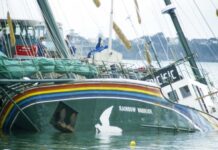From the Gulf News archives September 2021
The discovery of a pest seaweed at Aotea Great Barrier Island has led Biosecurity New Zealand to place legal controls on parts of the island while local mana whenua is imposing a rāhui over the same areas.
Caulerpa brachypus has been found in Blind Bay and Tryphena Harbour. It can spread rapidly and create dense mats smothering and displacing native species of algae, and is listed as an Unwanted Organism under the Biosecurity Act on the Official New Zealand Pest Register.
Biosecurity New Zealand’s director readiness and response, John Walsh, says the seaweed can be spread to new locations by small fragments and is easily moved by people going about water activities like boating, fishing, and dredging.
“We’re working with our partners, the Mana Whenua governance group and the local board to try to minimise this spread while we continue to assess where the pest seaweed is and what we can do in response,” Walsh says.
In place from Monday 20 September until at least the end of November, the Controlled Area Notice (CAN) makes it illegal to take seafood from Blind Bay or Tryphena Harbour. Anchoring in the two areas is also banned without a permit.
Ngāti Wai representative and deputy chair of the Governance Group for the biosecurity response, Martin Cleave, says the discovery of Caulerpa brachypus in Aotea waters, and the extent of the infestation, has been upsetting for mana whenua.
Cleave says that after robust discussions with mana whenua, and leadership from Rangatira Hori Parata, the hard and realistic call was made to impose a rāhui.
“Aotea is a precious and unique environment and we need to do everything to try to prevent this pest from spreading to other areas of our beautiful coastline. We urge people to comply with the rules.”
Under the CAN, it is illegal to remove any marine life (fish, seaweed, shellfish or crayfish) from the area and all equipment used for marine activities equipment – such as footwear, wetsuits, craypots, dredges and boat trailers – cannot be removed from the controlled zones without first checking for seaweed and removing it and leaving it in the area it came from.
Anyone wanting to move a boat that has been anchored out of the two affected bays can only do so with a permit.
Walsh says people can still swim, dive, paddle or use a vessel in the Controlled Areas, so long as they don’t drop anchor.
“It’s the movement of equipment along the seabed which poses the risk of picking up fragments of Caulerpa and moving it elsewhere,” he says.
Caulerpa brachypus has fronds up to 10cm long that rise from long runners or roots. In Australia, it is found growing below the tideline at between six to 10 metres on both hard surfaces and in sandy areas. After stormy weather it can wash up on the beach and it can be spread through breaking into little pieces by wave action or when anchors and fishing gear are moved through weed beds.
Those planning to visit Aotea coastal waters must check the rules at: www.biosecurity.govt.nz/caulerpa
Anyone who believes they have seen Caulerpa brachypus outside of Blind Bay or Tryphena Harbour should contact Biosecurity New Zealand on 0800 80 99 66.







